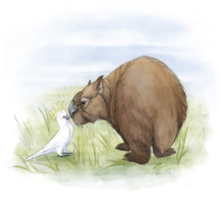Phascolonus
| Phascolonus Temporal range:
| |
|---|---|

| |
| Fossil cast at the American Museum of Natural History | |

| |
| Life restoration | |
| Scientific classification | |
| Domain: | Eukaryota |
| Kingdom: | Animalia |
| Phylum: | Chordata |
| Class: | Mammalia |
| Infraclass: | Marsupialia |
| Order: | Diprotodontia |
| Family: | Vombatidae |
| Genus: | †Phascolonus Owen, 1872 |
| Species | |
| |
| Synonyms | |
| |

Phascolonus is an extinct genus of giant wombat known from the Pliocene[1] and Pleistocene of Australia. There is only a single known species, Phascolonus gigas, the largest wombat ever known to have existed, estimated to weigh as much as 200 kg (450 lb)[2] or 360 kg (790 lb).[3] It was described by Richard Owen in 1859. Phascolomys magnus is a probable junior synonym.[3] P. gigas is distinguished from other wombats by its strap-shaped upper incisors. The cranial roof also is noticeably inwardly depressed.[3] The species was abundant across Australia, with remains having been found in all states except Western Australia. It is suggested to have had a preference for arid and semi-arid inland habitats, with a diet consisting of a high amount of low quality vegetation. Though it likely had wide home-ranges, it probably did not stray far from fresh water sources.[4] Abundant remains have been found in Pleistocene aged deposits from Lake Callabonna in South Australia.[3] Unlike its living relatives, it is unlikely that Phascolonus engaged in burrowing.[5] Phascolonus disappeared during the Late Pleistocene Quaternary extinction event around 50-40,000 years ago, together with many other large Australian animals, following the arrival of humans to the Australian continent.[4][6] Phylogenetic analysis suggests that is closely related to the other giant wombat genera Ramsayia and Sedophascolomys.[3]
References
[edit]- ^ Louys, Julien (3 July 2015). "Wombats (Vombatidae: Marsupialia) from the Pliocene Chinchilla Sand, southeast Queensland, Australia". Alcheringa: An Australasian Journal of Palaeontology. 39 (3): 394–406. doi:10.1080/03115518.2015.1014737. ISSN 0311-5518.
- ^ Long, John A.; Archer, Michael; Flannery, Tim & Hand, Suzanne (2002). Prehistoric Mammals of Australia and New Guinea: One Hundred Million Years of Evolution. University of New South Wales Press. pp. 161–162. ISBN 978-0-8018-7223-5. OCLC 49860159.
- ^ a b c d e Louys, Julien; Duval, Mathieu; Beck, Robin M. D.; Pease, Eleanor; Sobbe, Ian; Sands, Noel; Price, Gilbert J. (November 2022). Hautier, Lionel (ed.). "Cranial remains of Ramsayia magna from the Late Pleistocene of Australia and the evolution of gigantism in wombats (Marsupialia, Vombatidae)". Papers in Palaeontology. 8 (6). doi:10.1002/spp2.1475. hdl:10072/420259. ISSN 2056-2799.
- ^ a b Dawson, Lyndall (January 2006). "An ecophysiological approach to the extinction of large marsupial herbivores in middle and late Pleistocene Australia". Alcheringa: An Australasian Journal of Palaeontology. 30 (sup1): 89–114. doi:10.1080/03115510609506857. ISSN 0311-5518.
- ^ Woolnough, Andrew P.; Steele, Vernon R. (March 2001). "The palaeoecology of the Vombatidae: did giant wombats burrow?". Mammal Review. 31 (1): 33–45. doi:10.1046/j.1365-2907.2001.00077.x. ISSN 0305-1838.
- ^ Hocknull, Scott A.; Lewis, Richard; Arnold, Lee J.; Pietsch, Tim; Joannes-Boyau, Renaud; Price, Gilbert J.; Moss, Patrick; Wood, Rachel; Dosseto, Anthony; Louys, Julien; Olley, Jon; Lawrence, Rochelle A. (18 May 2020). "Extinction of eastern Sahul megafauna coincides with sustained environmental deterioration". Nature Communications. 11 (1): 2250. doi:10.1038/s41467-020-15785-w. ISSN 2041-1723. PMC 7231803. PMID 32418985.
- Owen, Richard (1858). "Odontology". The Encyclopedia Britannica, or Dictionary of Arts, Sciences and General Literature. Vol. 16 (Eighth ed.). pp. 447, 450, figure 80.
- Stirling, Edward Charles & Zietz, Amandus Heinrich Christian (1899). "Preliminary notes on Phascolonus gigas, Owen [Phascolomys (Phascolonus) gigas, Owen] and its identity with Sceparnodon ramsayi Owen". Transactions of the Royal Society of South Australia. 23: 123–135 – via BHL.
- "Phascolonus gigas". The Recently Extinct Plants and Animals Database. Retrieved 14 September 2022.
- "It's a wombat, but not like you know it…". South Australian Museum. 13 May 2022. Retrieved 14 September 2022.


